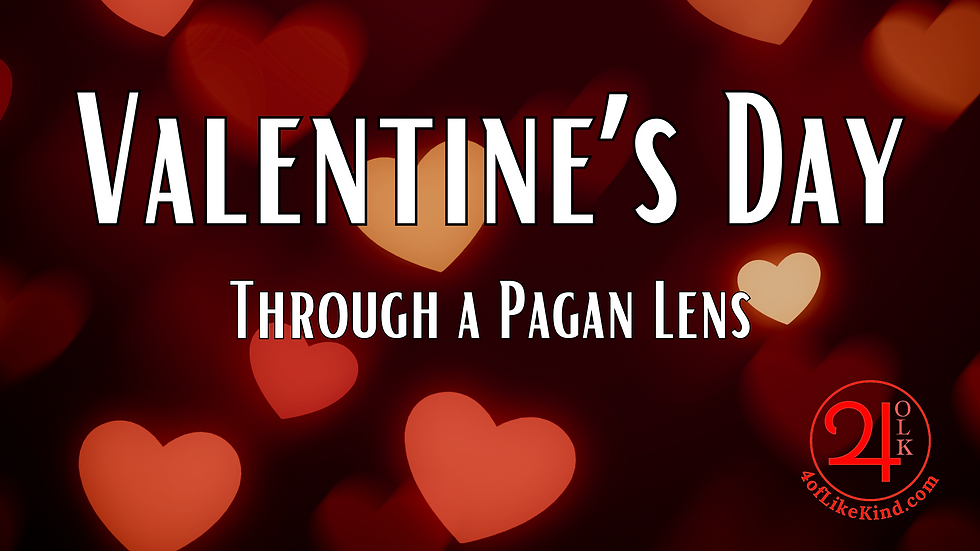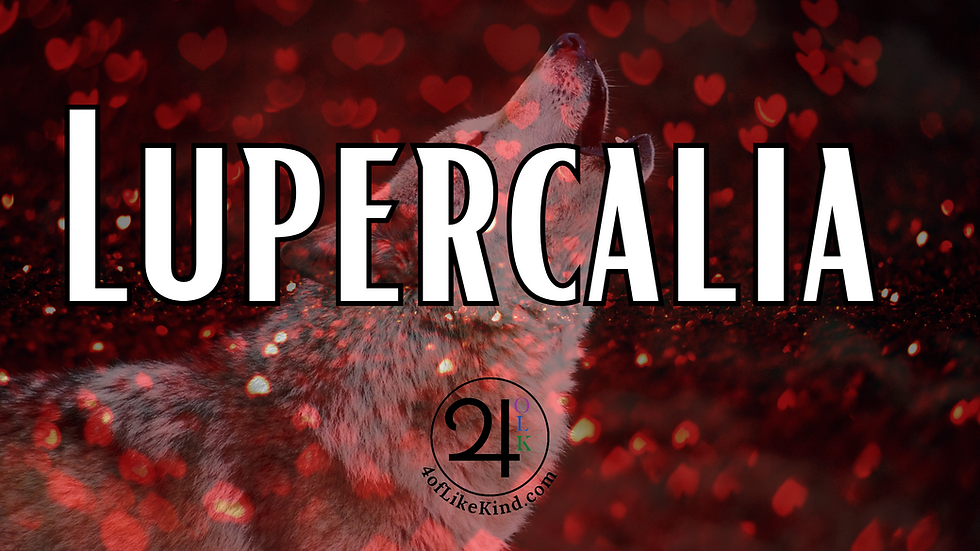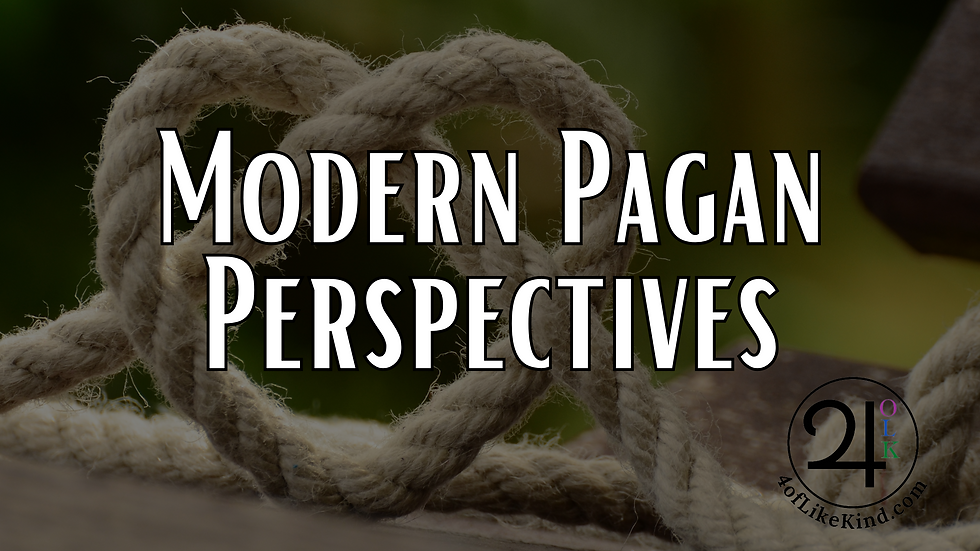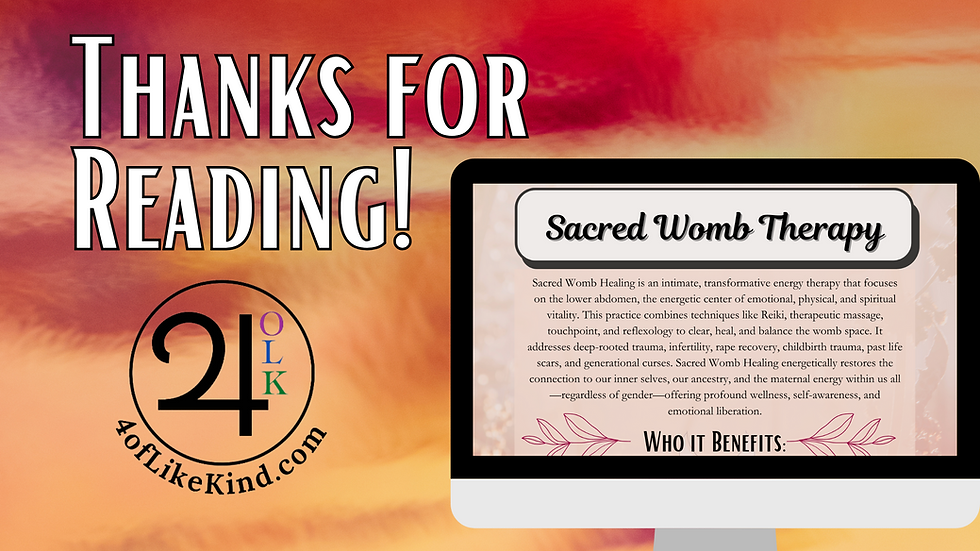Valentine’s Day Through a Pagan Lens: Love, History, and Self-Care
- 4 of Like Kind
- Feb 5
- 11 min read

Valentine's Day has grown into a global celebration of love, but its roots reach far beyond modern associations to chocolates and roses.
For Pagans, this season is rich with history, myth, and opportunities to honor love in all its forms—romantic, platonic, self, and divine. This post explores Valentine’s Day’s origins, modern Pagan perspectives, and how to embrace authentic love and self-care. We’ll also dive into similar traditions, famous Pagan couples, and empowering messages from goddesses of love and strength.

The Origins of Valentine’s Day
Valentine’s Day traces back to ancient Rome with the festival of Lupercalia, celebrated around February 15.
Lupercalia, an ancient Roman festival held in mid-February, was a time of purification, fertility, and celebrating the return of spring. It honored the god Lupercus, protector of flocks and herds, as well as Faunus, the rustic god of the forest, often depicted as half-man, half-goat. The festival featured rituals aimed at ensuring fertility and warding off evil, including sacrifices and playful rites led by priests known as Luperci.
Lupercalia was also associated with the she-wolf, Lupa, who nursed the legendary twins Romulus and Remus, the mythical founders of Rome. The festival's themes of purification, protection, and renewal were integral to its celebration, which would later influence modern Valentine's Day traditions. The feast and rituals linked to Lupercalia reflect the Roman people’s deep connection to nature, agriculture, and their pantheon of deities.

Lupercalia's incorporation into the Christian tradition is often seen as a strategic move by the early Church to align pagan customs with Christian celebrations, easing the transition for Roman citizens to Christianity. In the 5th century, Pope Gelasius I officially declared Lupercalia a pagan festival and sought to replace it with a more Christian-oriented feast. This led to the establishment of St. Valentine's Day on February 14th, a day honoring the Christian martyr named Valentine.
St. Valentine's Day, as it became known, adopted some of the festive aspects of Lupercalia, such as themes of love and fertility, but shifted the focus to saintly reverence and the ideals of Christian charity and devotion. The ritualistic, often raucous nature of Lupercalia, which included sacrifice and revelry, was softened in the new Christian context. However, many of the cultural elements surrounding love, courtship, and fertility survived through the evolution of St. Valentine's Day celebrations.
The melding of Lupercalia’s themes with Christian customs helped the Church absorb and transform the pagan festival, ultimately creating a new celebration centered on love, kindness, and respect for Christian values.

Modern Pagan Perspectives on Valentine’s Day
Our Pagan life coaching program invites you to explore Valentine’s Day beyond commercialized romance. For modern Pagans, this season aligns with Imbolc (celebrated February 1-2), marking the stirrings of spring and the return of warmth and light. Themes of transformation, love, and potential resonate, making it an ideal time to honor love’s many expressions.
Romantic Love: Celebrate with your partner through shared rituals or symbolic gestures.
Community Love: Strengthen friendships with acts of kindness and appreciation.
Self-Love: Create a sacred space for self-care, focusing on your emotional and spiritual needs.
Love, in Pagan belief, is not limited to one person or form—it flows in cycles, like nature itself.

Other Traditions of Love Around the World
Valentine’s Day isn’t the only celebration of love during this season. Here are a few global and spiritual counterparts:
Japan and South Korea:
On February 14, women gift chocolates to men, often distinguishing between “giri-choco” (obligation chocolate for colleagues or friends) and “honmei-choco” (romantic chocolate for loved ones). Then, a month later on White Day (March 14), men return the favor with gifts like chocolates, candies, or other tokens, often giving back something of greater value. This reciprocal exchange adds a layer of meaning and balance to their Valentine customs!
China’s Qixi Festival:
The Qixi Festival, also known as the Chinese Valentine’s Day, celebrates the romantic legend of the Cowherd and the Weaver Girl. According to Chinese mythology, these star-crossed lovers, represented by the stars Altair and Vega, are separated by the Milky Way and can only reunite once a year on the 7th day of the 7th lunar month (this year approximately August 10th). Traditionally, the festival honors love, craftsmanship, and celestial beauty. Couples exchange gifts, stargaze, and participate in activities like crafting and praying for blessings in love and marriage. This ancient festival beautifully intertwines romance and tradition, lighting up hearts across China each year
Ancient Greece Gamelion:
Gamelion, the seventh month of the ancient Attic calendar, corresponds roughly to late January and early February in the Gregorian calendar. Named after the Greek word "gamos," meaning marriage, this month was sacred to the goddess Hera and celebrated the divine union of Hera and Zeus. Festivities often included the Gamelia, a marriage-focused festival honoring their sacred bond, with rituals emphasizing partnership, fertility, and community harmony. This period aligned with midwinter, symbolizing renewal and preparation for the growing season. Gamelion serves as a reminder of balance in relationships and the cycles of life.
These traditions remind us that love, whether divine or human, is a universal and timeless force.

Famous Pagan Couples and Their Lessons
In mythology, Pagan couples symbolize the many faces of love. Here are a few:

Isis and Osiris (Egyptian):
Representing loyalty, partnership, and eternal love, their story teaches us the power of devotion and transformation.
The story of Isis and Osiris is a cornerstone of Egyptian mythology, representing loyalty, partnership, and transformation. Osiris, a benevolent ruler and god of the afterlife, was killed by his jealous brother Set, who sealed him in a coffin and cast it into the Nile. Grief-stricken, Isis, the goddess of magic and motherhood, tirelessly searched for Osiris's body. Using her divine powers, she resurrected him long enough to conceive their son, Horus. Osiris then became the ruler of the underworld, while Horus grew up to avenge his father and defeat Set, reclaiming justice and balance.
This myth symbolizes the cycles of life, death, and rebirth, as well as the transformative power of love and devotion. Isis's unwavering determination highlights the strength of loyalty, while Osiris’s resurrection reflects the promise of renewal. Their story influenced later myths and religions, with Isis becoming a universal symbol of protection and magic. It remains a timeless reminder of resilience, justice, and the eternal nature of love.

Freya and Óðr (Norse):
The Norse goddess Freya, associated with love, beauty, and magic, shares a poignant story of devotion with her husband, Óðr. When Óðr went missing, Freya wept tears of red gold, her sorrow symbolizing the profound depth of love and the sacrifices it often entails. Her grief drove her to search across the Nine Realms, showcasing her resilience and unyielding devotion.
This myth encapsulates the emotional power of love and the value of perseverance in the face of loss. Freya’s tears turning into gold also symbolize the transformative nature of love and sorrow, turning pain into something precious. Her story reminds us of the enduring strength found in love, even through heartbreak and longing.

Danu and Bile (Celtic):
In Celtic mythology, Danu and Bile are revered as the divine parents of the Tuatha Dé Danann, the deities and heroes of Irish tradition. Danu, a goddess of rivers, fertility, and wisdom, represents the nurturing power of the Earth, while Bile, associated with death and the Otherworld, embodies the cyclical balance of life. Together, they symbolize creation and the sacred connection between the physical and spiritual realms.
Their union gave rise to the Tuatha Dé Danann, who brought knowledge, magic, and prosperity to the land. As the ancestors of the Celtic people, Danu and Bile remind us of the interconnectedness of all life and the enduring link between humanity and the natural world. Their story reflects the harmony of creation, transformation, and the eternal flow of existence.
These partnerships inspire us to honor love’s transformative and creative powers, whether in relationships or within ourselves.

Goddess Messages for Female Empowerment
Love and empowerment often walk hand in hand, especially when guided by goddesses. Here are three powerful messages from love-related goddesses:
Aphrodite (Greek): Celebrate Your Unique Beauty and Passions
Aphrodite’s energy invites you to honor the beauty that exists within and around you. Her bold, unapologetic love reminds us that embracing our desires is an act of self-empowerment. Celebrate the essence of what makes you you—your quirks, passions, and dreams are all a part of your divine spark. Let your love for yourself radiate outward, drawing in the experiences and connections that match your energy.
Affirmation:
I am a vessel of beauty and passion. I embrace my desires and express my love boldly and unapologetically.
Brigid (Celtic): Nurture Your Inner Fire and Heal Through Creation
Brigid, the goddess of poetry, healing, and smithcraft, teaches us the sacredness of nurturing ourselves and others. As the goddess of Imbolc, she symbolizes the return of light and life. Channel her energy to fuel your inner fire, take care of your well-being, and create something meaningful in your life. Whether it's crafting, journaling, or tending to your emotional health, every act of self-care and creativity is a sacred offering to yourself.
Affirmation:
I am the keeper of my inner flame. I nurture my well-being and heal through creation and care.
Oshun (Yoruba): Flow with Life’s Rhythms and Embrace Abundance
Oshun’s love flows like her sacred rivers—gentle yet powerful. She reminds us that self-love and joy are not indulgent but necessary for a fulfilling life. By flowing with life’s rhythms, Oshun teaches us to find abundance and sweetness even in moments of stillness. Let her energy inspire you to embrace life’s pleasures and build a foundation of self-love that nourishes your spirit.
Affirmation:
I flow with the rhythms of life, finding joy, love, and abundance in every moment. I am enough just as I am.
These goddesses remind us that true love begins with embracing our authentic selves.
Embracing Authentic Self-Care During This Season
Valentine’s Day is a beautiful time to turn inward and reflect on love’s role in your life. Here are some self-care rituals to try:
Create a Sacred Love Altar:
Elevate your love altar beyond the ordinary by weaving deeper symbolism into its design. Begin with rhodonite, a crystal of compassion and heart-healing, to invite balance and selfless love. Pair it with garnet to ignite passion and deepen connection. Add pink opal, known for nurturing the heart and fostering emotional understanding.
For color symbolism, layer fabrics or items in shades of deep red for passion, soft pink for tenderness, and white to represent pure intentions. Incorporate green elements, like malachite or fresh greenery, to evoke growth and renewal in your relationships.
Enhance the altar with natural elements like a shell or sea glass to symbolize emotional flow, and anoint a carved beeswax candle with rose or sandalwood oil to amplify love’s energy. Finally, include a personal token—a handwritten note, a ring, or a photograph—to anchor the space with your unique intention.
This thoughtful combination creates a potent space for invoking love in all its transformative forms.

Practice Heart-Centered Meditation:
Sit in a comfortable, grounded position, and bring your awareness to the heart chakra, the center of love, compassion, and connection. Located at the chest, this chakra governs emotional balance and relationships. Its energy flows freely when we are open-hearted and accepting, but blockages often arise as we carry unhealed pain, fear, or resentment.
Blockages in the heart chakra might manifest as feelings of loneliness, jealousy, or difficulty in trusting others. You may feel closed off or emotionally distant, or even experience chest tightness, shallow breathing, or a lack of self-compassion. When the heart chakra is blocked, it can make it challenging to give and receive love authentically.
As you inhale deeply, visualize a gentle green light—the color of the heart chakra—filling your chest, softening any tension. With each breath, let go of any emotions tied to old wounds, letting them dissolve into the light. Repeat these meditative phrases silently or aloud:
"I open my heart to love and acceptance."
"I release all fear and allow love to flow freely."
"My heart is a wellspring of compassion, for myself and others."
"I forgive, I heal, I am whole."
Continue this type of meditation for at least ten minutes, feeling the warmth of self-love and compassion expanding through your body. With each breath, imagine fear and resentment being released, replaced by the lightness of unconditional love. This practice restores harmony and openness, reconnecting you to the profound energy of the heart.

Write a Self-Love Letter:
Take a moment to sit quietly and reflect on your journey. Write a letter to yourself, celebrating all that you are. Acknowledge your strengths, the resilience you've shown in challenging times, and the growth you've experienced. Remind yourself of the dreams you are actively working towards and the steps you've already taken to bring them closer. Express gratitude for your unique qualities and the lessons you’ve learned, recognizing the ways you’ve transformed and continue to evolve. Let this letter be a beautiful, empowering reminder of your worth and potential, filled with love and affirmation for your journey ahead.

Pamper Yourself:
Create a sacred space for deep healing by preparing a restorative ritual bath that nurtures both body and spirit. Begin by lighting candles in soft, soothing colors like lavender or deep blue to calm the mind and encourage relaxation. As you draw your bath, add a blend of soothing herbs such as chamomile, lavender, and lemongrass—known for their calming and restorative properties. You can place these herbs in a muslin bag or tea infuser, allowing their oils to steep in the warm water, or simply add the loose herbs directly for a more immersive experience. Consider adding Epsom salt or Himalayan pink salt to the water to release tension, toxins and promote relaxation.
As you enter the bath, allow yourself to fully relax, closing your eyes and breathing deeply to release any accumulated stress or negative energy. Visualize the warmth of the water drawing out tension, while the healing energy of the herbs replenishes you. With each inhale, absorb their healing properties—restoring both your body and spirit.
After soaking for at least 20 minutes, continue your self-care ritual with a restorative self-massage. Start by gently massaging aroma-infused oil into your temples, neck, and shoulders to release tightness. Using slow, intentional strokes, work the oil into your arms, legs, and feet, focusing on areas where you feel tension or discomfort. For deeper relief, use your thumbs or knuckles to apply gentle pressure to areas of built-up tension, particularly along the back, neck, or the base of the skull.
As you move through the massage, repeat restorative affirmations:
“I release all tension and open myself to healing.”
“My body is a vessel of peace, strength, and restoration.”
“I honor my energy, and I nurture my spirit.”
Finish the ritual by resting quietly in stillness for a few moments, allowing the effects of the herbs, warm water, and massage to fully integrate into your being. This bath and self-care practice can help restore balance, soothe overworked muscles, and bring emotional tranquility, leaving you grounded, nourished, and renewed.
Self-care is an act of love that radiates outward, influencing your relationships and energy.
Book a Relationship Tarot Reading:
Ready to gain clarity and insight into your relationships? Whether you're seeking guidance on love, connection, or communication, a Tarot reading can provide reflective insights into your dynamics and help illuminate the path forward. Book your session today and explore the deeper energies shaping your relationships.
A Season of Love and Light
Valentine’s Day offers us a chance to reconnect with love’s sacred energy, whether through honoring mythology, celebrating personal relationships, or nurturing our inner selves. By blending ancient wisdom with modern practices, Pagans can embrace this season as a time of empowerment, joy, and transformation.
Let the whispers of Isis, Aphrodite, and Brigid guide you as you walk this path of love, remembering that it starts within and flows outward to the world around you.

Now is the perfect time to embark on the transformative journey of past life exploration. As an act of self-love, delving into the mysteries of your past lives can uncover hidden patterns, unresolved emotions, and karmic lessons that may be influencing your present. By understanding who you were, you gain deeper clarity about who you are now, allowing for greater healing and self-empowerment.
This exploration invites you to release old wounds, recognize strengths you’ve carried through lifetimes, and embrace a more complete sense of self. It’s a sacred opportunity to reconnect with your soul’s journey, fostering growth, acceptance, and a deeper connection to your highest potential.














WebAsha Technologies is a premier Ethical Hacking Training Institute in Pune. We are dedicated to providing industry-relevant training with cutting-edge tools and methodologies. Our institute offers theoretical knowledge and practical application to ensure learners gain real-world cybersecurity experience.